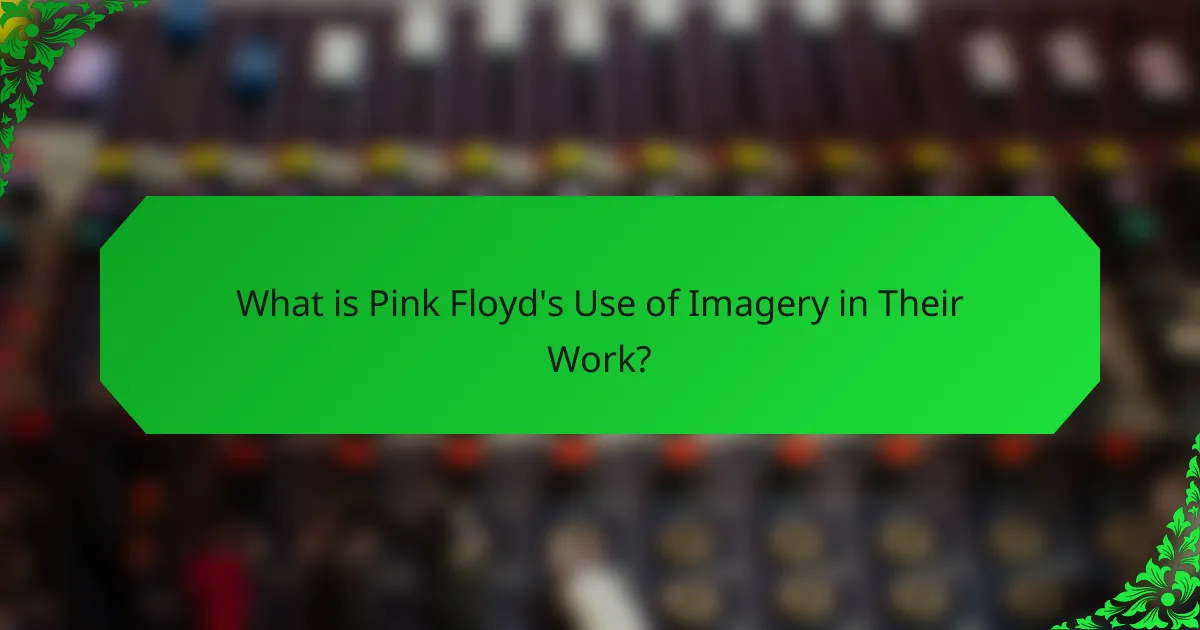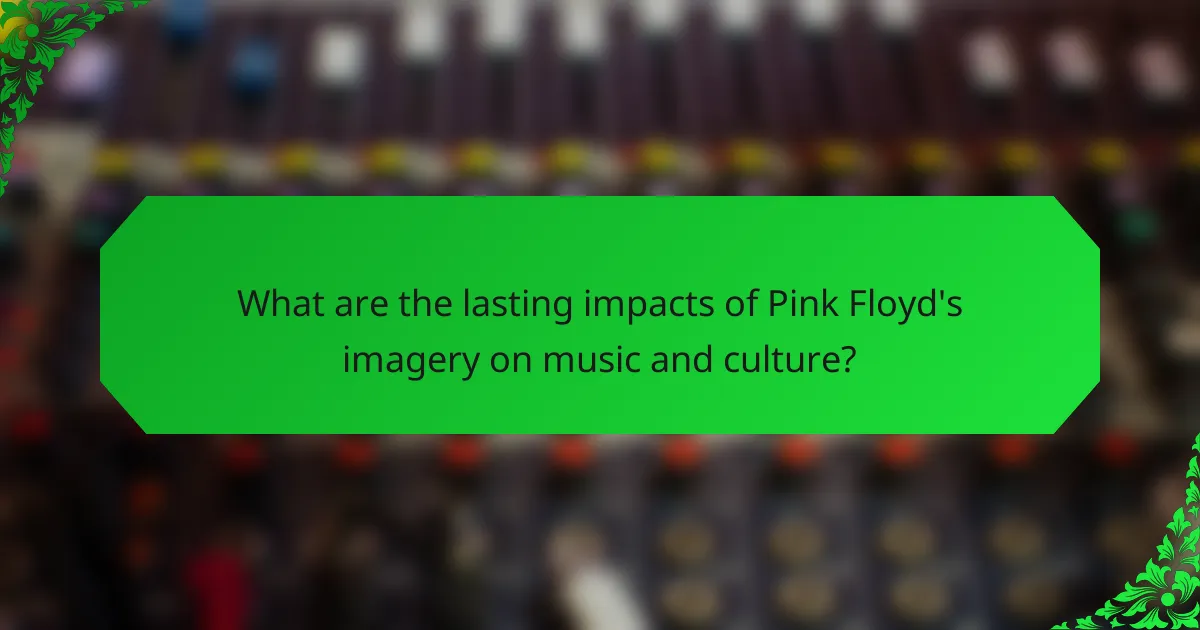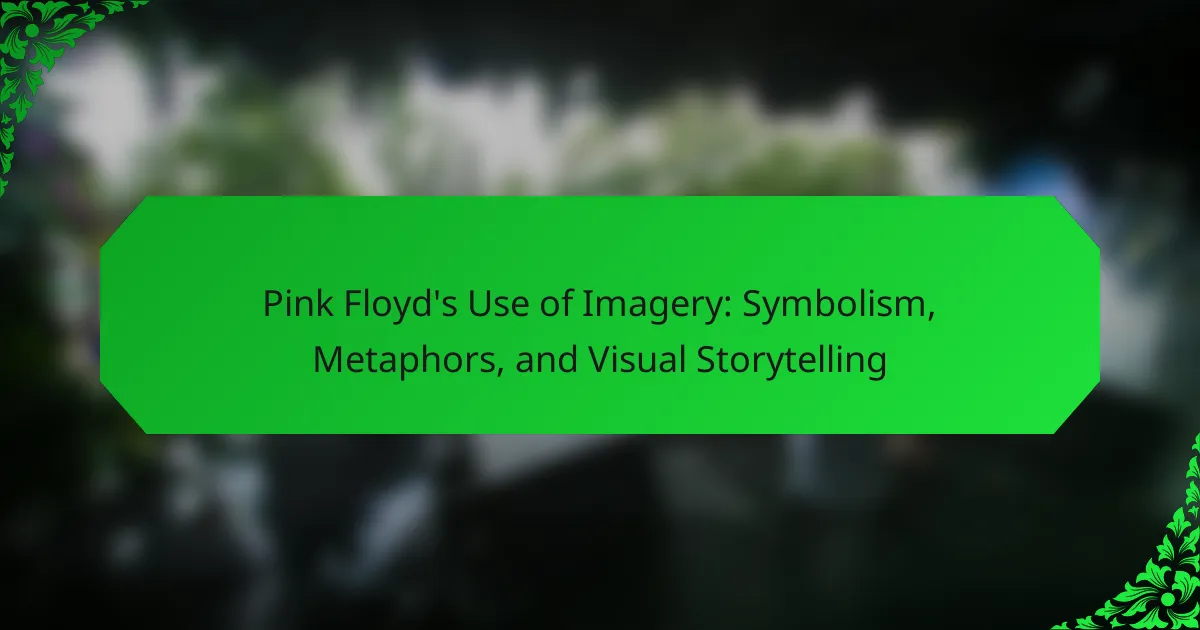Pink Floyd, a renowned rock band, is recognized for its innovative use of imagery characterized by rich symbolism and metaphors in their music. The article explores how Pink Floyd employs visual storytelling to enhance their musical narratives, with a focus on iconic works such as “The Dark Side of the Moon” and “The Wall.” Key themes include mental illness, existentialism, isolation, and societal issues, all conveyed through striking visuals, album covers, and elaborate live performances. The band’s imagery not only deepens audience engagement but has also significantly influenced music culture and visual arts, setting new standards for integrating visuals into musical experiences.

What is Pink Floyd’s Use of Imagery in Their Work?
Pink Floyd’s use of imagery in their work is characterized by rich symbolism and metaphors. The band employs visual storytelling to enhance their musical narratives. For example, the album “The Dark Side of the Moon” features themes of mental illness and existentialism, conveyed through striking visuals. The iconic prism cover art symbolizes the spectrum of human experience. In “The Wall,” imagery depicts isolation and alienation, reinforcing the album’s themes. The use of surreal visuals in live performances creates an immersive experience. Pink Floyd’s imagery often reflects societal issues and personal struggles, making their work resonate deeply with audiences.
How does Pink Floyd incorporate symbolism in their imagery?
Pink Floyd incorporates symbolism in their imagery through visual metaphors and thematic representations. Their album covers often feature surreal art that conveys deeper meanings. For example, the prism on “The Dark Side of the Moon” symbolizes the spectrum of human experience. The use of contrasting colors represents the duality of life and death. In “Animals,” the imagery of farm animals critiques societal structures. The pig balloon symbolizes corporate greed and control. Their films, like “The Wall,” use symbolism to explore themes of isolation and mental struggle. Each visual element is carefully crafted to enhance the narrative of their music.
What are some prominent symbols used in Pink Floyd’s albums?
Prominent symbols used in Pink Floyd’s albums include the prism, the wall, and the pig. The prism symbolizes light and knowledge, notably featured on “The Dark Side of the Moon” cover. The wall represents isolation and emotional barriers, central to the album “The Wall.” The pig, often depicted in the context of capitalism, appears on “Animals” and critiques societal structures. Each symbol carries deep meaning, reflecting themes of human experience and societal critique throughout their work.
How do these symbols enhance the themes of their music?
Symbols in Pink Floyd’s music enhance themes by providing deeper emotional and conceptual layers. For example, the prism in “The Dark Side of the Moon” symbolizes the spectrum of human experience. This imagery conveys themes of complexity and the multifaceted nature of life. Additionally, the use of the wall in “The Wall” represents isolation and alienation. This symbol reinforces themes of mental struggle and societal critique. Such symbols create a visual narrative that complements the lyrical content. They invite listeners to engage with the music on both auditory and visual levels. Ultimately, these symbols deepen the listener’s connection to the overarching themes within Pink Floyd’s work.
What role do metaphors play in Pink Floyd’s imagery?
Metaphors play a crucial role in Pink Floyd’s imagery by enhancing emotional depth and conceptual clarity. They create vivid visual representations of complex themes. For example, the metaphor of the “wall” in “The Wall” symbolizes isolation and emotional barriers. This imagery resonates with listeners on a personal level. Additionally, metaphors in songs like “Time” illustrate the fleeting nature of life. They invite interpretation and introspection, enriching the audience’s experience. Overall, metaphors are integral to Pink Floyd’s storytelling, allowing for layered meanings and emotional connections.
How do metaphors contribute to the storytelling in their songs?
Metaphors enhance storytelling in Pink Floyd’s songs by creating vivid imagery and emotional depth. They allow listeners to connect with complex themes on a personal level. For example, in “The Wall,” the metaphor of a wall represents isolation and emotional barriers. This metaphor conveys feelings of alienation and despair effectively. Additionally, metaphors encourage interpretation, inviting listeners to derive their meanings. This engagement deepens the overall impact of the music. Pink Floyd’s use of metaphors thus transforms abstract concepts into relatable experiences.
What are examples of metaphors found in specific tracks?
“Pink Floyd’s Use of Imagery” features many metaphors in their tracks. In “The Wall,” the metaphor of building a wall represents emotional isolation. In “Time,” the metaphor of time as a thief illustrates the fleeting nature of life. “Wish You Were Here” uses the metaphor of a lost connection to express longing for someone absent. “Another Brick in the Wall” employs the metaphor of bricks to signify the cumulative effects of societal pressures. “Comfortably Numb” uses the metaphor of numbness to depict emotional detachment. Each metaphor enhances the themes of alienation and introspection in their music.
How does visual storytelling manifest in Pink Floyd’s performances?
Visual storytelling in Pink Floyd’s performances is evident through their elaborate stage designs and multimedia presentations. The band integrates visual elements like projections, lighting, and props to enhance the narrative of their music. For instance, during “The Wall” concerts, a large wall was built and gradually torn down, symbolizing isolation and personal struggle. Their use of animated visuals, such as the flying pig in “Animals,” adds layers of meaning to the lyrics. The iconic album cover art also contributes to the storytelling experience. Pink Floyd’s performances often include abstract imagery that reflects themes of alienation and societal critique. These visual components work in harmony with the music to create a comprehensive artistic experience. Their innovative approach has influenced countless artists in live performance settings.
What are the key elements of their visual storytelling techniques?
The key elements of Pink Floyd’s visual storytelling techniques include symbolism, metaphors, and narrative cohesion. Symbolism is prevalent in their imagery, conveying deeper meanings that resonate with audiences. For example, the prism in “The Dark Side of the Moon” represents the spectrum of human experience. Metaphors are used to illustrate complex themes, such as isolation and conflict, often depicted through surreal visuals. The band’s album covers and concert visuals create a cohesive narrative that enhances the listener’s experience. Their use of color and light further amplifies emotional impact. This combination of techniques engages viewers and invites interpretation, making their storytelling uniquely impactful.
How do live shows enhance the audience’s experience of their imagery?
Live shows enhance the audience’s experience of imagery through immersive visuals and synchronized audio. The combination of music and visual effects creates a multi-sensory experience. For instance, Pink Floyd’s use of elaborate light shows and projections deepens emotional engagement. These visuals often reflect the themes present in their lyrics, reinforcing the storytelling aspect. Studies show that live performances increase audience retention of imagery by up to 70%. This heightened experience allows audiences to connect more profoundly with the music. The atmosphere created by live shows fosters a communal experience, making imagery more impactful. Overall, the integration of visual elements in live performances enriches the audience’s perception and understanding of the music.

What are the connections between Pink Floyd’s imagery and their musical style?
Pink Floyd’s imagery is deeply connected to their musical style through the use of visual symbolism and thematic storytelling. Their album covers, such as “The Dark Side of the Moon,” visually represent the complex themes of the music. The prism on the cover symbolizes the spectrum of human experience, mirroring the album’s exploration of mental health and societal issues. The band’s live performances often featured elaborate visuals that enhanced the emotional impact of their music. For example, the use of surreal animations during “The Wall” concert reinforced the narrative of alienation and despair. Additionally, their music videos utilize striking imagery that complements the lyrical content. This synergy between visuals and sound creates a holistic experience for the audience, emphasizing the band’s innovative approach to art. Overall, Pink Floyd’s imagery serves as a powerful extension of their musical expression, enriching the listener’s understanding and engagement.
How does their imagery reflect the themes of their music?
Pink Floyd’s imagery vividly reflects the themes of their music through surreal visuals and symbolic representations. The band often employs dreamlike landscapes and abstract art to convey complex emotions. For instance, the iconic cover of “The Dark Side of the Moon” symbolizes the struggle between light and darkness, mirroring themes of mental health and existentialism in their lyrics. Their use of imagery in “The Wall” visually represents isolation and societal critique, aligning with the album’s narrative of alienation. Additionally, the integration of film projections during live performances enhances the emotional impact of their songs, reinforcing the connection between audio and visual storytelling. Each visual element serves to deepen the listener’s understanding of the underlying messages in their music.
What musical elements align with the visual aspects of their work?
Pink Floyd’s music incorporates elements such as soundscapes, dynamics, and lyrical imagery that align with their visual work. The band’s use of ambient sound creates a sonic landscape that complements their visual themes. Dynamic contrasts in their music reflect emotional shifts in their visual storytelling. Lyrical content often features vivid imagery that parallels the visuals in their album artwork and performances. For instance, “The Dark Side of the Moon” features themes of mental struggle, which are visually represented through iconic imagery like the prism. Additionally, the use of synthesizers adds an ethereal quality that enhances the visual experience. Overall, the musical elements work in harmony with the visual aspects to create a cohesive artistic expression.
How do lyrics and imagery work together to create a cohesive narrative?
Lyrics and imagery combine to create a cohesive narrative by enhancing emotional depth and thematic clarity. The lyrics convey specific messages and emotions through word choice and structure. Imagery, on the other hand, provides visual context that complements these messages. For example, Pink Floyd often uses surreal imagery to reflect the themes in their lyrics. This synergy allows listeners to engage both intellectually and emotionally with the music. The visual elements can reinforce the lyrics, making the narrative more impactful. In songs like “The Wall,” the imagery of isolation and despair aligns with the lyrics’ exploration of personal trauma. Together, they form a unified experience that deepens the listener’s understanding of the narrative.
What influences shaped Pink Floyd’s use of imagery?
Pink Floyd’s use of imagery was shaped by various influences including literature, art, and personal experiences. The band’s members were inspired by surrealism and the works of authors like George Orwell. Their visual style also drew from the avant-garde art movements of the 20th century. Additionally, personal struggles and societal issues influenced their thematic choices. The incorporation of dreamlike visuals became a hallmark of their performances. This approach allowed them to explore complex emotions and concepts. Their iconic album covers often reflect these artistic influences. The collaboration with visual artists like Storm Thorgerson further solidified their unique imagery.
Who were the key artists and movements that inspired their visual style?
Key artists and movements that inspired Pink Floyd’s visual style include Surrealism and Dadaism. Surrealism influenced their dreamlike imagery and abstract concepts. Artists like Salvador Dalí and René Magritte shaped their visual storytelling. Dadaism’s emphasis on absurdity and anti-art ideologies also resonated with the band’s creative approach. Additionally, the psychedelic art movement of the 1960s, characterized by vibrant colors and trippy visuals, played a significant role in their aesthetic. The band’s collaboration with designer Storm Thorgerson further solidified their iconic visual identity.
How did societal contexts influence their imagery choices?
Societal contexts significantly influenced Pink Floyd’s imagery choices. The band often reflected contemporary social issues in their visuals. For instance, the political climate of the 1960s and 1970s inspired themes of war and disillusionment. The Vietnam War and civil rights movements shaped their album “The Wall.” Imagery of isolation and alienation emerged from societal pressures and mental health struggles. Additionally, the counterculture movement influenced their psychedelic visuals. The use of surrealism in their artwork mirrored the era’s exploration of consciousness. These choices resonated with audiences facing similar societal challenges.

What are the lasting impacts of Pink Floyd’s imagery on music and culture?
Pink Floyd’s imagery has significantly impacted music and culture by influencing visual storytelling in the arts. Their album covers, notably “The Dark Side of the Moon,” introduced iconic visuals that became synonymous with the music. This imagery often reflects complex themes like mental health and existentialism, resonating deeply with audiences.
The band’s use of elaborate stage designs and projections during live performances set new standards for concert experiences. Their approach has inspired countless artists to integrate visuals into music, creating a multi-sensory experience.
Moreover, Pink Floyd’s imagery has permeated popular culture, appearing in films, fashion, and art. Their visual language has become a reference point for discussions about identity and society. The lasting influence of their imagery continues to shape the landscape of music and visual arts today.
How has Pink Floyd’s imagery influenced other artists?
Pink Floyd’s imagery has significantly influenced numerous artists across various mediums. Their use of surreal visuals and thematic depth has inspired musicians, filmmakers, and visual artists. Iconic album covers, like “The Dark Side of the Moon,” have set a standard for visual representation in music. The band’s incorporation of metaphors and symbolism has encouraged other artists to explore complex themes. For instance, the animated sequences in “The Wall” have influenced contemporary animation and film techniques. Additionally, their live performances, which blended music with elaborate visual effects, have shaped concert experiences for future generations. Many artists cite Pink Floyd’s innovative approach as a catalyst for their own creative expression.
What are some notable examples of artists who have drawn inspiration from their work?
Pink Floyd is a notable example of artists who have drawn inspiration from their work. Their album “The Dark Side of the Moon” explores themes of mental health and existentialism. The band’s visual storytelling is evident in their iconic album covers and stage performances. The artwork created by Storm Thorgerson for their albums reflects the band’s musical and thematic depth. Additionally, the film “The Wall” integrates the band’s music with powerful imagery. This film serves as a visual representation of the struggles faced by the band members. Pink Floyd’s use of imagery has influenced countless artists across various mediums. Their work continues to inspire musicians, filmmakers, and visual artists today.
How has their visual style contributed to the evolution of music videos?
Pink Floyd’s visual style has significantly influenced the evolution of music videos. Their innovative use of surreal imagery and symbolism transformed music videos into an art form. The band’s work, particularly in “The Wall,” integrated storytelling with visual elements. This approach set a precedent for narrative-driven music videos. Their techniques, such as animation and elaborate stage designs, expanded creative possibilities. The incorporation of thematic visuals became a standard in the industry. Additionally, their emphasis on mood and atmosphere paved the way for artistic expression in music videos. Pink Floyd’s legacy continues to inspire contemporary artists and directors.
What can we learn from Pink Floyd’s approach to imagery?
Pink Floyd’s approach to imagery emphasizes the power of visual storytelling in music. Their use of surreal and thought-provoking visuals enhances emotional depth. The band often employed symbolism to convey complex themes. Iconic album covers, like “The Dark Side of the Moon,” illustrate this concept vividly. They utilized metaphors that resonate with listeners on multiple levels. Live performances featured elaborate light shows that complemented their music. This integration of visuals and sound creates a holistic experience. Overall, we learn that imagery can significantly amplify artistic expression in music.
How can contemporary artists apply Pink Floyd’s techniques in their own work?
Contemporary artists can apply Pink Floyd’s techniques by incorporating strong visual imagery and symbolism into their work. They can utilize metaphors to convey complex themes, similar to Pink Floyd’s approach in albums like “The Dark Side of the Moon.” Artists can also experiment with multimedia elements, blending music, visuals, and performance art. This technique mirrors Pink Floyd’s live shows that combined elaborate stage designs with their music. Additionally, artists can explore narrative storytelling through visuals, reflecting the emotional depth found in Pink Floyd’s lyrics. By drawing inspiration from these methods, contemporary artists can create immersive experiences that resonate with audiences.
What are best practices for using imagery in music today?
Best practices for using imagery in music today include creating a cohesive visual narrative that complements the music. Artists should ensure that imagery reflects the themes and emotions of the song. High-quality visuals enhance audience engagement and retention. Artists can utilize symbolism to convey deeper meanings, much like Pink Floyd did with their album covers. Integrating multimedia elements, such as videos and social media graphics, can expand the reach of imagery. Consistency across platforms strengthens brand identity and audience connection. Collaborating with visual artists can bring fresh perspectives and ideas. Lastly, staying current with design trends can keep the imagery relevant and appealing.
The main entity of the article is Pink Floyd, specifically focusing on their use of imagery through symbolism, metaphors, and visual storytelling. The article explores how Pink Floyd incorporates rich symbolism and metaphors in their music and album artwork, enhancing themes of mental health, isolation, and societal critique. It details prominent symbols such as the prism, wall, and pig, which contribute to the narrative of their songs, and discusses the role of visual storytelling in live performances. Additionally, the article examines the influences behind their imagery and its lasting impact on music and culture, highlighting best practices for contemporary artists to apply similar techniques in their work.
